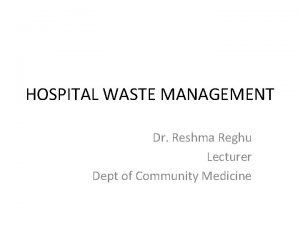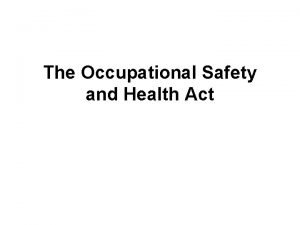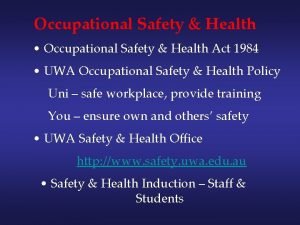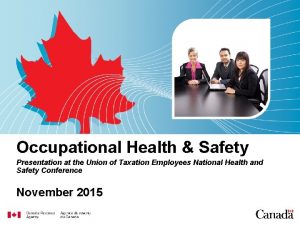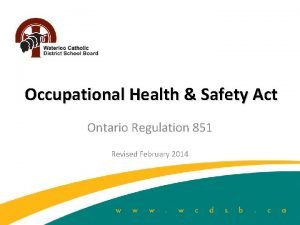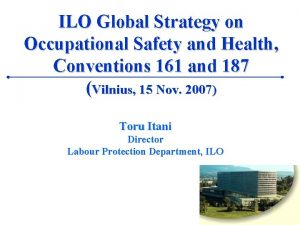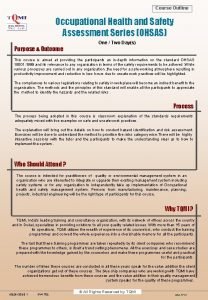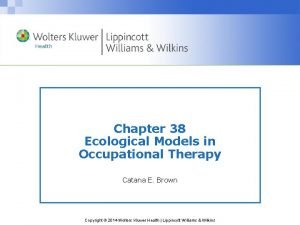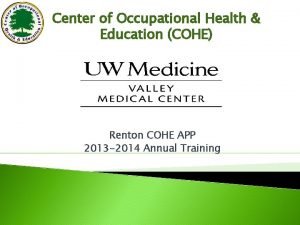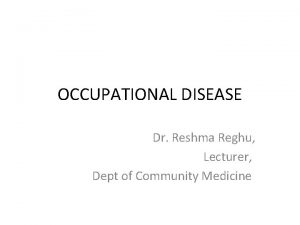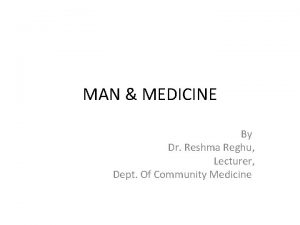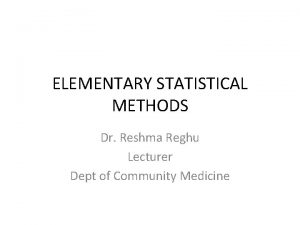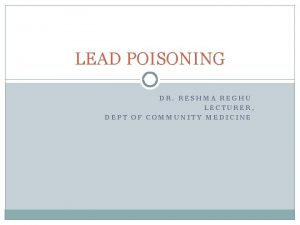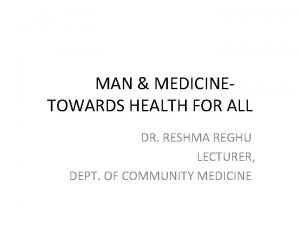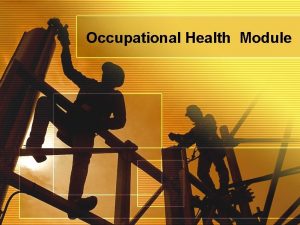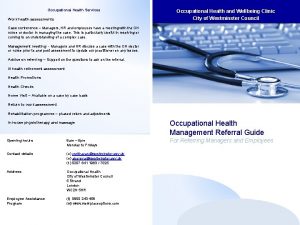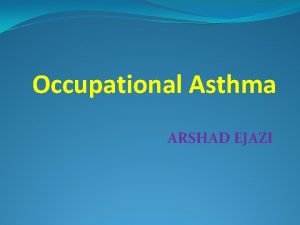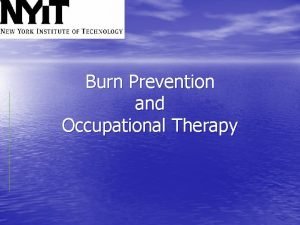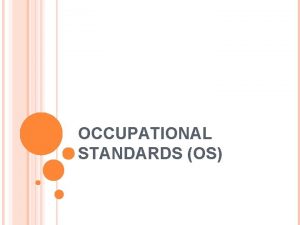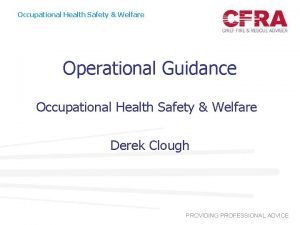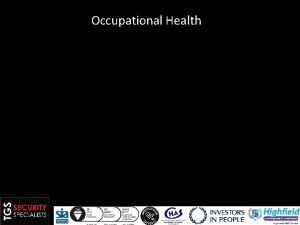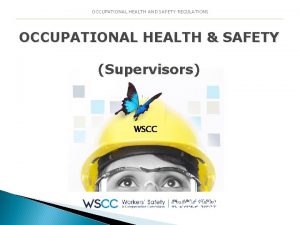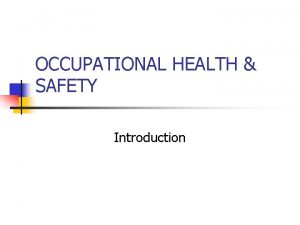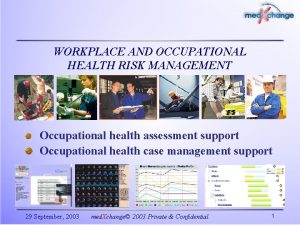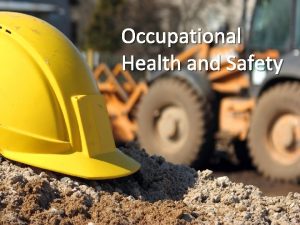OCCUPATIONAL HEALTH Dr Reshma Reghu Lecturer Dept of





























- Slides: 29

OCCUPATIONAL HEALTH Dr. Reshma Reghu Lecturer, Dept. of Community Medicine

Defn. The joint ILO/WHO Committee on Occupational health, in course of its 1 st session held on 1950 as Occupational health should aim at the �promotion & maintenance of the highest degree of physical, mental and social well being of workers in all occupation. �Prevention among workers of departures from health caused by their working condition. �Protection of workers in their employment from risks resulting from factors adverse to health �Placing & maintenance of the worker in an occupational environment adapted to his physiological & psychological equipment �And to summarize the adaptation of work to man & each man to his work

Level of application of preventive measures �Health promotion �Specific protection �Early diagnosis & treatment �Disability limitation & Rehabilitation �Epidemiological approach �Statistics �Health Screening �Health Education

ERGONOMICS �Integral part of advanced occupational health service �The word derived from Greek “Ergon” means work & “nomos” means law simply means “fitting the job to the worker” �Objective – To achieve the best mutual adjustment of man and his work, for the improvement of human efficiency and well being. �To reduce industrial accidents. �Training involves designing of machines, tools, equipment & manufacturing process, lay out of the places of work, methods of work & environment.

3 types of interaction in a working place �Man and physical, chemical & biological agents �Man and machine � Man and man OCCUPATIONAL ENVIRONMENT

�PHYSICAL AGENTS: Heat, Cold, Humidity, Air movement, Heat Radiation, Light, Noise, Vibration. �CHEMICAL AGENTS: Chemicals, Toxic dust, Gases �BIOLOGICAL AGENTS: Viral, Bacterial, Parasitic etc. . Man & Physical, Chemical & Biological Agents

�Unguarded machines, protruding and moving parts, poor installation of the plant, lack of safety measures can cause accidents �Working for long hours in unphysiological posture can cause fatigue, backache, disease of joints and muscles and impairment of worker’s health and efficiency MAN & MACHINE

�Human relationships amongst workers �Authority over them �Towards domestic environment MAN & MAN

a) Physical Hazards a) Chemical Hazards b) Biological Hazards c) Mechanical Hazards d) Psychosocial Hazards OCCUPATIONAL HAZARDS

�Heat & Cold �Light �Noise �Vibration �Ultra violet Radiation �Ionizing radiation PHYSICAL HAZARDS

�Local action �Inhalation a) Dust particles <5 microns respirable dust b) Gases- Simple , Asphyxiated & Anaesthetic gases c) Metals & their compounds �Ingestion CHEMICAL HAZARDS

Exposed to infective and parasitic agents �Brucellosis �Leptospirosis �Tetanus �Fungal infections BIOLOGICAL HAZARDS

� 10% of accidents are due to mechanical causes MECHANICAL HAZARDS

�Frustration �Lack of job satisfaction �Insecurity �Poor human relationship �Emotional tension Classified as 2 categories �Psychological & Behavioural changes �Psychosomatic ill health PSYCHOSOCIAL HAZARDS

�Disease due to physical agents �Disease due to chemical agents �Disease de to biological agents �Occupational Cancers �Occupational dermatitis �Disease of Psychological origin OCCUPATIONAL DISEASE

Disease due to physical agents �Heat- Heat hyperpyrexia, heat exhaustion, heat syncope, heat cramps, burns & local effects �Cold- Trench foot, Frost bite, Chilblains �Light- Occupational Cataracts, Miner’s Nystagmus �Pressure- Caisson disease, Air embolism, Blast �Noise- Occupational Deafness �Radiation- Cancer, Leukemia, Aplastic anemia, Pancytopenia �Mechanical Factors- Injuries, Accidents �Electricity- Burns

Disease due to chemical agents �Gases: CO 2, CO, HCN, CS 2, NH 3, N 2, H 2 S, HCl, SO 2 - these cause gas poisoning. �Dusts: (Pneumoconiosis) INORGANIC DUST 1. Coal dust- Anthracosis 2. Silica- Silicosis 3. Asbestos- Asbestosis, CA Lung 4. Iron- Siderosis ORGANIC DUST 1) Cane fibre- Bagassosis 2) Cotton dust- Byssinosis 3) Tobacco- Tabaccosis 4) Hay or grain dust- Farmer’s Lung

�Metals & their compounds: Lead, Mercury, Cadmium, Manganese, Beryllium, Arsenic, Chromium �Chemicals: Acids, Alkalies, pesticides �Solvents: Carbon bisulphide, Benzene, Trichloroethylene, Chloroform etc. .

�Disease due to biological agents: Brucellosis, Leptospirosis, Anthrax, Actinomycosis, Hydatidosis, Tetanus, Encephalitis, Fungal infections etc. . �Occupational cancers: Cancer of skin, lung & bladder �Occupational dermatitis: Dermatitis, Eczema �Disease of psychological origin: Industrial neurosis, hypertension, peptic ulcer.

PNEUMOCONIOSIS The disease depends upon § Chemical composition § Fineness § Concentration of dust in the air § Period of exposure § Individual susceptibility The important dust diseases are �SILICOSIS �ANTHRACOSIS �BYSSINOSIS �BAGASSOSIS �ASBESTOSIS �FARMER’S LUNG

SILICOSIS �Major cause of permanent disability & mortality �Free silica & silicon dioxide �Incubation period vary from few months to 6 years �Pathologically characterized by nodular fibrosis in the upper part of lungs. �Impairment in lung capacity �X-ray shows, snow-storm appearance �Prone to silico- tuberculotics

�Rigorous dust control measures - Substitution - Complete enclosure - Isolation - Hydroblasting - Good house keeping - Personal protective measures �Regular physical examination of workers �Notifiable disease under Factories Act 1948 & Mines Act 1952 PREVENTIVE MEASURES

ANTHRACOSIS � 2 phase o Simple pneumoconiosis o Progressive massive fibrosis- 12 years exposure- severe respiratory disability to premature death o Risk of death is more among coal miners o Indian Mines Act of 1952 & Workmen’s Compensation (Amendment) Act of 1959.

�Inhalation of cotton fibre �Chronic bronchitis & emphysema �Textile Industry BYSSINOSIS

BAGASSOSIS �Inhalation of sugarcane dust �Thermoactinomyces sacchari �Acute diffuse bronchiolitis, mottling in lungs, impairment in pulmonary function �Untreated, diffuse fibrosis, emphysema & bronchiectasis �PREVENTIVE MEASURES a) Dust control b) Personal protection c) Medical control d) Bagasse control

ASBESTOSIS �Asbestos fibres are 20 – 500 micron length and 0. 5 - 50 micron diameter �Used in manufacture of asbestos cement, fireproof textiles, roof tiling, brake lining etc. . �Enters into the body by inhalation causing pulmonary fibrosis due to mechanical irritation and is peri- bronchial & diffuse in character, basal in location contrast to silicosis. In advanced cases, clubbing of fingers, cardiac distress & cyanosis. Sputum shows asbestos bodies i. e, asbestos fibres coated with fibrin. X-ray shows ground glass appearance in lower two third of lung field.

� 2 Types i. Serpentine or Chrysolite variety- 90% Hydrated magnesium silicate ii. Amphibole- little magnesium. It has different variaties viz; Crocidolite(blue), Amosite (brown), Anthrophyllite (white). Mesothelioma- rare cancer of pleura & peritoneum has strong association with crocidolite variety of asbestos.

�Use of safer types of asbestos �Substitution of other insulants- glass fibres, mineral wool, calcium silicate �Rigorous dust control �Periodic examination of workers- biological monitoring �Continuing research PREVENTIVE MEASURES

�Inhalation of moldy hay or grain dust �Growth of thermophilic actinomycetes of which Micropolyspora faeni �Repeated attack cause pulmonary fibrosis, pulmonary damage & corpulmonale �Widespread in India FARMER’S LUNG
 Lecturer's name
Lecturer's name Role of community health nurse in occupational health
Role of community health nurse in occupational health Reshma is a garment worker in dhaka
Reshma is a garment worker in dhaka Dr reshma mohammed
Dr reshma mohammed Jeannie watkins
Jeannie watkins Spe distinguished lecturer
Spe distinguished lecturer Good morning teacher good morning teacher
Good morning teacher good morning teacher Photography lecturer
Photography lecturer Lecturer in charge
Lecturer in charge Designation lecturer
Designation lecturer Designation of lecturer
Designation of lecturer Gcwak
Gcwak Lecturer name
Lecturer name Pearson lecturer resources
Pearson lecturer resources 140000/120
140000/120 Lector vs lecturer
Lector vs lecturer Lecturer in charge
Lecturer in charge Cfa lecturer handbook
Cfa lecturer handbook Lecturer asad ali
Lecturer asad ali Williams-steiger occupational safety and health act of 1970
Williams-steiger occupational safety and health act of 1970 Chcp occupational health
Chcp occupational health Occupational health and safety act 1984
Occupational health and safety act 1984 Occupational health and safety presentation
Occupational health and safety presentation Regulation 851
Regulation 851 Define occupational health nursing
Define occupational health nursing Ipac competencies
Ipac competencies Global strategy on occupational safety and health
Global strategy on occupational safety and health Occupational health and safety course outline
Occupational health and safety course outline Confluence health occupational medicine
Confluence health occupational medicine Occupational health services renton
Occupational health services renton



